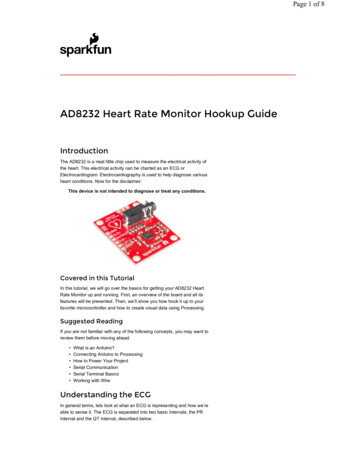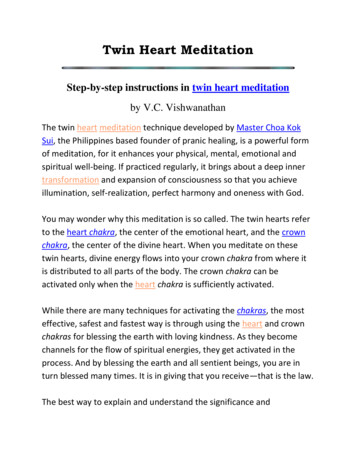
Transcription
1SCIENCE OF THE HEART:Exploring the Role of the Heart in Human PerformanceAn Overview of Research Conducted by the Institute of -of-the-heart.html1. Introduction2. Heart Rate Variability3. Entrainment, Coherence & Autonomic Balance4. Head-Heart Interactions5. Emotional Balance & Health6. Music Research7. HeartMath Technology in Business8. HeartMath in Education9. Clinical Research10. Assessment Services11. Scientific Advisory Board & Physics of Humanity Council12. Bibliography1.IntroductionFor centuries, the heart has been considered the source of emotion, courage and wisdom.At the Institute of HeartMath (IHM) Research Center, we are exploring the physiologicalmechanisms by which the heart communicates with the brain, thereby influencinginformation processing, perceptions, emotions and health. We are asking questions suchas: Why do people experience the feeling or sensation of love and other positive emotionalstates in the area of the heart and what are the physiological ramifications of theseemotions? How do stress and different emotional states affect the autonomic nervoussystem, the hormonal and immune systems, the heart and brain? Over the years we haveexperimented with different psychological and physiological measures, but it wasconsistently heart rate variability, or heart rhythms, that stood out as the most dynamic andreflective of inner emotional states and stress. It became clear that negative emotions leadto increased disorder in the heart’s rhythms and in the autonomic nervous system, therebyadversely affecting the rest of the body. In contrast, positive emotions create increasedharmony and coherence in heart rhythms and improve balance in the nervous system. Thehealth implications are easy to understand: Disharmony in the nervous system leads toinefficiency and increased stress on the heart and other organs while harmonious rhythmsare more efficient and less stressful to the body’s systems.More intriguing are the dramatic positive changes that occur when techniques are appliedthat increase coherence in rhythmic patterns of heart rate variability. These include shifts inperception and the ability to reduce stress and deal more effectively with difficult situations.We observed that the heart was acting as though it had a mind of its own and wasprofoundly influencing the way we perceive and respond to the world. In essence, itappeared that the heart was affecting intelligence and awareness.The answers to many of our original questions now provide a scientific basis to explainhow and why the heart affects mental clarity, creativity, emotional balance and personaleffectiveness. Our research and that of others indicate that the heart is far more than asimple pump. The heart is, in fact, a highly complex, self-organized information processing
2center with its own functional "brain" that communicates with and influences the cranialbrain via the nervous system, hormonal system and other pathways. These influencesprofoundly affect brain function and most of the body’s major organs, and ultimatelydetermine the quality of life.Figure 1.Innervation of the major organs by the autonomic nervous system (ANS). Parasympatheticfibers pass through the cranium and sacrum; sympathetic fibers are associated with thethoracic and lumbar vertebrae. Proper functioning of the ANS is critical for themaintenance of health, while a number of health problems are associated with ANSdysfunction or imbalance. Emotions greatly affect the activity of the ANS and the balancebetween the two branches. For example, anger causes increased sympathetic activity andreduced parasympathetic. Constriction of the arteries resulting from excessive sympatheticstimulation can contribute to hypertension and heart attacks.Compiled by Rollin McCraty, Mike Atkinson and Dana Tomasino. HeartMath ResearchCenter, Institute of HeartMath, Publication No. 01-001. Boulder Creek, CA, 2001.All rights reserved. No part of this book may be translated or reproduced in any formwithout the written permission of the publisher.HeartMath , Freeze-Frame , Heart Lock-In , Cut-Thru , and Inner Quality Management (IQM) are registered trademarks of the Institute of HeartMath. The emWave PC EmotionalManagement Enhancer (FFEME) is a trademark of Quantum Intech.The Intelligent HeartSome of the first modern psychophysiological researchers to examine the conversationsbetween the heart and brain were John and Beatrice Lacey. During 20 years of researchthroughout the 1960s and ’70s, they observed that the heart communicates with the brainin ways that significantly affect how we perceive and react to the world.A generation before the Laceys began their research, Walter Cannon had shown thatchanges in emotions are accompanied by predictable changes in heart rate, blood
3pressure, respiration and digestion. In Cannon’s view, when we are "aroused," themobilizing part of the nervous system (sympathetic) energizes us for fight or flight, and inmore quiescent moments, the calming part of the nervous system (parasympathetic) coolsus down. In this view, it was assumed that the autonomic nervous system and all of thephysiological responses moved in concert with the brain’s response to a given stimulus.Presumably, our inner systems tooled up together when we were aroused and simmereddown together when we were at rest, and the brain was in control of the entire process.The Laceys noticed that this simple model only partially matched actual physiologicalbehavior. As their research evolved, they found that the heart seemed to have its ownpeculiar logic that frequently diverged from the direction of the autonomic nervous system.The heart appeared to be sending meaningful messages to the brain that it not onlyunderstood, but obeyed. Even more intriguing was that it looked as though thesemessages could affect a person’s behavior. Shortly after this, neurophysiologistsdiscovered a neural pathway and mechanism whereby input from the heart to the braincould "inhibit" or "facilitate" the brain’s electrical activity. Then in 1974, the Frenchresearchers Gahery and Vigier, working with cats, stimulated the vagus nerve (whichcarries many of the signals from the heart to the brain) and found that the brain’s electricalresponse was reduced to about half its normal rate. In summary, evidence suggested thatthe heart and nervous system were not simply following the brain’s directions, as Cannonhad thought.Neurocardiology: The Brain in the HeartWhile the Laceys were doing their research in psychophysiology, a small group ofcardiovascular researchers joined with a similar group of neurophysiologists to exploreareas of mutual interest. This represented the beginning of the new discipline ofneurocardiology, which has since provided critically important insights into the nervoussystem within the heart and how the brain and heart communicate with each other via thenervous system.After extensive research, one of the early pioneers in neurocardiology, Dr. J. AndrewArmour, introduced the concept of a functional "heart brain" in 1991. His work revealed thatthe heart has a complex intrinsic nervous system that is sufficiently sophisticated to qualifyas a "little brain" in its own right. The heart’s brain is an intricate network of several types ofneurons, neurotransmitters, proteins and support cells like those found in the brain proper.Its elaborate circuitry enables it to act independently of the cranial brain – to learn,remember, and even feel and sense. The recent book Neurocardiology, edited by Dr.Armour and Dr. Jeffrey Ardell, provides a comprehensive overview of the function of theheart’s intrinsic nervous system and the role of central and peripheral autonomic neuronsin the regulation of cardiac function. The nervous system pathways between the heart andbrain are shown in Figure 2.The heart’s nervous system contains around 40,000 neurons, called sensory neurites,which detect circulating hormones and neurochemicals and sense heart rate and pressureinformation. Hormonal, chemical, rate and pressure information is translated intoneurological impulses by the heart’s nervous system and sent from the heart to the brainthrough several afferent (flowing to the brain) pathways. It is also through these nervepathways that pain signals and other feeling sensations are sent to the brain. Theseafferent nerve pathways enter the brain in an area called the medulla, located in the brainstem. The signals have a regulatory role over many of the autonomic nervous systemsignals that flow out of the brain to the heart, blood vessels and other glands and organs.
4However, they also cascade up into the higher centers of the brain, where they mayinfluence perception, decision making and other cognitive processes.Dr. Armour describes the brain and nervous system as a distributed parallel processingsystem consisting of separate but interacting groups of neuronal processing centersdistributed throughout the body. The heart has its own intrinsic nervous system thatoperates and processes information independently of the brain or nervous system. This iswhat allows a heart transplant to work: Normally, the heart communicates with the brain vianerve fibers running through the vagus nerve and the spinal column. In a heart transplant,these nerve connections do not reconnect for an extended period of time, if at all; however,the transplanted heart is able to function in its new host through the capacity of its intact,intrinsic nervous system.The Heart BrainThe intrinsic cardiac nervous system, or heart brain, is made up of complex ganglia,containing afferent (receiving) local circuit (interneurons) and efferent (transmitting)sympathetic and parasympathetic neurons. Multifunctional sensory neurites, which aredistributed throughout the heart, are sensitive to many types of sensory input originatingfrom within the heart itself. The intrinsic cardiac ganglia integrate messages from the brainand other processing centers throughout the body with information received from thecardiac sensory neurites. Once information has been processed by the heart’s intrinsicneurons, the appropriate signals are sent to the sinoatrial and atrioventricular nodes aswell as the muscles in the heart. Thus, under normal physiological conditions, the heart’sintrinsic nervous system plays an important role in much of the routine control of cardiacfunction, independent of the central nervous system. Dr. Armour and his colleagues haveshown that the heart’s intrinsic nervous system is vital for the maintenance ofcardiovascular stability and efficiency, and that without it, the heart cannot operateproperly.
5Figure 2.The neural communication pathways between the heart and the brain. The heart’s intrinsicnervous system consists of ganglia, which contain local circuit neurons of several types,and sensory neurites, which are distributed throughout the heart. The intrinsic gangliaprocess and integrate inflowing information from the extrinsic nervous system and from thesensory neurites within the heart. The extrinsic cardiac ganglia, located in the thoraciccavity, have direct connections to organs such as the lungs and esophagus and are alsoindirectly connected via the spinal cord to many other organs, including the skin andarteries. The "afferent" (flowing to the brain) parasympathetic information travels from theheart to the brain through the vagus nerve to the medulla, after passing through thenodose ganglion. The sympathetic afferent nerves first connect to the extrinsic cardiacganglia (also a processing center), then to the dorsal root ganglion and the spinal cord.Once afferent signals reach the medulla, they travel to the subcortical areas (thalamus,amygdala, etc.) and then to the cortical areas.The Heart as a Hormonal GlandAnother component of the heart-brain communication system was provided by researchersstudying the hormonal system. The heart was reclassified as an endocrine or hormonalgland, when in 1983 a hormone produced and released by the heart called atrial natriureticfactor (ANF) was isolated. This hormone exerts its effects widely: on the blood vesselsthemselves, on the kidneys and the adrenal glands and on a large number of regulatoryregions in the brain. Dr. Armour and his students also found that the heart contains a celltype known as "intrinsic cardiac adrenergic" (ICA) cells. These cells are classified as"adrenergic" because they synthesize and release catecholamines (norepinephrine anddopamine), neurotransmitters once thought to be produced only by neurons in the brain
6and ganglia outside the heart. More recently still, it was discovered that the heart alsosecretes oxytocin, commonly referred to as the "love" or "bonding hormone." Beyond itswell-known functions in childbirth and lactation, recent evidence indicates that thishormone is also involved in cognition, tolerance, adaptation, complex sexual and maternalbehaviors as well as in the learning of social cues and the establishment of enduring pairbonds. Remarkably, concentrations of oxytocin in the heart are as high as those found inthe brain.Had the complexity of the heart’s intrinsic nervous system and the extensive influence ofits hormonal secretions been more widely understood by the scientific community while theLaceys were doing their research, their theories might have been accepted far earlier;however, their insight and experimentation played an important role in elucidating the basicphysiological and psychological processes that connect mind and body. In 1977, Dr.Francis Waldropin, Director of the National Institute of Mental Health, stated in a reviewarticle of the Laceys’ work that: "Their intricate and careful procedures, combined with theirdaring theories, have produced work that has stirred controversy as well as promise. In thelong run, their research may tell us much about what makes each of us a whole personand may suggest techniques that can restore a distressed person to health."Indeed, this prediction has come to pass. Doc Childre and the Institute of HeartMath havebuilt upon the work of others such as the Laceys and Dr. Armour to develop practicalinterventions that incorporate the understanding that the heart profoundly affectsperception, awareness and intelligence. This technology has now helped thousands ofindividuals from many walks of life lead more productive, healthy and fulfilling lives bylearning to live more with heart and mind in synchrony, operating from a constructivesynergy of the intelligence of both mind and heart.The Mental and Emotional SystemsDating back to the ancient Greeks, human think ing and feeling, or intellect and emotion,have been considered separate functions. These contrasting aspects of the soul, as theGreeks called them, have often been portrayed as being engaged in a constant battle forcontrol of the human psyche. In Plato’s view, emotions were like wild horses that had to bereined in by the intellect, while Christian theology has long equated emotions with sins andtemptations to be resisted by reason and willpower.Of course, emotions are not always negative and do not always serve as antagonists torational thought. Neurologist Antonio Damasio stresses the rationality of emotion in hisbook Descartes’ Error, where he emphasizes the importance of emotions in decisionmaking. He points out that patients with brain damage in the areas of the brain thatintegrate the emotional and cognitive systems can no longer effectively function in the dayto-day world, even though their mental abilities are perfectly normal. In the recentbestselling book Emotional Intelligence, Daniel Goleman argues that the pervading view ofhuman intelligence as essentially mind intellect is far too narrow, for it ignores a range ofhuman capacities that bear equal if not greater weight in determining our successes in life.He builds a case for a largely overlooked domain of intelligence, termed "emotionalintelligence," which is based on such qualities as self-awareness, motivation, altruism andcompassion. According to Goleman, it is a high "EQ" (emotional quotient) as much or morethan a high IQ that marks people who excel in the face of life’s challenges.The latest research in neuroscience confirms that emotion and cognition can best bethought of as separate but interacting functions or systems, each with its unique
7intelligence. Our research is showing that the key to the successful integration of the mindand emotions lies in increasing the coherence (ordered, harmonious function) in bothsystems and bringing them into phase with one another. While two-way communicationbetween the cognitive and emotional systems is hard-wired into the brain, the actualnumber of neural connections going from the emotional centers to the cognitive centers isgreater than the number going the other way. This goes some way to explain thetremendous power of emotions, in contrast to thought alone. Once an emotion isexperienced, it becomes a powerful motivator of future behaviors, affecting moment-tomoment actions, attitudes and long-term achievements. Emotions can easily bumpmundane events out of awareness, but non-emotional forms of mental activity (likethoughts) do not so readily displace emotions from the mental landscape. Likewise,experience reminds us that the most pervasive thoughts – those least easily dismissed –are typically those fueled by the greatest intensity of emotion. Because emotions exertsuch a powerful influence on cognitive activity, at IHM we have discovered that interveningat the emotional level is often the most efficient way to initiate change in mental patternsand processes. Our research demonstrates that the application of tools and techniquesdesigned to increase coherence in the emotional system can often bring the mind intogreater coherence as well.It is our experience that the degree of coherence between the mind and emotions can varyconsiderably. When they are out-of-phase, overall awareness is reduced. Conversely,when they are in-phase, awareness is expanded. This interaction affects us on a numberof levels: Vision, listening abilities, reaction times, mental clarity, feeling states andsensitivities are all influenced by the degree of mental and emotional coherenceexperienced at any given moment.Increasing Psychophysiological Coherence: The Role of the HeartThe results of research studies summarized in this overview, taken together, support theintriguing view that individuals can gain more conscious control over the process ofcreating increased coherence within and between the mental and emotional systems thanmight be commonly believed. This, in turn, can lead to greater physiological coherence,manifesting as more ordered and efficient function in the nervous, cardiovascular,hormonal and immune systems. We call the resulting state psychophysiologicalcoherence, as it involves a high degree of balance, harmony and synchronization withinand between cognitive, emotional and physiological processes. Research has shown thatthis state is associated with high performance, reduced stress, increased emotionalstability and numerous health benefits. (The concept of coherence is discussed in furtherdetail in the Entrainment, Coherence and Autonomic Balance section). At IHM, we havefound that the heart plays a central role in the generation of emotional experience, andtherefore, in the establishment of psychophysiological coherence. From a systemsperspective, the human organism is truly a vast, multi-dimensional information network ofcommunicating subsystems, in which mental processes, emotions, and physiologicalsystems are inextricably intertwined. Whereas our perceptions and emotions were oncebelieved to be dictated entirely by the brain’s responses to stimuli arising in our externalenvironment, the current perspective more accurately describes perceptual and emotionalexperience as the composite of stimuli the brain receives from the external environmentand the internal sensations or feedback transmitted to the brain from the bodily organs andsystems. Thus, the heart, brain, nervous, hormonal and immune systems must all beconsidered fundamental components of the dynamic, interactive information network thatdetermines our ongoing emotional experience.
8Extensive work by eminent brain researcher and neurosurgeon, Dr. Karl Pribram, hashelped advance the understanding of the emotional system. In Pribram’s model, pastexperience builds within us a set of familiar patterns, which are established and maintainedin the neural networks. Inputs to the brain from both the external and internal environmentscontribute to the maintenance of these patterns. Within the body, many processes andinteractions occurring at different functional levels provide constant rhythmic inputs withwhich the brain becomes familiar. These inputs range from the rhythmic activity of ourheart, to our digestive, respiratory and reproductive rhythms, to the constant interplay ofmessenger molecules produced by the cells of our body.These inputs to the brain, translated into neural and hormonal patterns, are continuouslymonitored by the brain and help organize our perception, feelings and behavior. Familiarinput patterns from the external environment and from within the body are ultimatelywritten into neural circuitry and form a stable backdrop, or reference pattern, against whichnew information or experiences are compared. According to this model, when an externalor internal input is sufficiently different from the familiar reference pattern, this "mismatch"or departure from the familiar underlies the generation of feelings and emotions.The background physiological patterns with which our brain and body grow familiar arecreated and reinforced through our experiences and the way we perceive the world. Forexample, a person living in an environment that continually triggers angry or fearfulfeelings is likely to become familiar with these feelings, and with their neural and hormonalcorrelates. In contrast, an individual whose experience is dominated by feelings of security,love and care will become "familiar" with the physiological patterns associated with thesefeelings.In our internal environment many different organs and systems contribute to the patternsthat ultimately determine our emotional experience. However, research has illuminated thatthe heart plays a particularly important role. The heart is the most powerful generator ofrhythmic information patterns in the human body. As we saw earlier, it functions assophisticated information encoding and processing center, and possesses a far moredeveloped communication system with the brain than do most of the body’s major organs.With every beat, the heart not only pumps blood, but also transmits complex patterns ofneurological, hormonal, pressure and electromagnetic information to the brain andthrough-out the body. As a critical nodal point in many of the body’s interacting systems,the heart is uniquely positioned as a powerful entry point into the communication networkthat connects body, mind, emotions and spirit."Since emotional processes can work faster than the mind, it takes a power stronger thanthe mind to bend perception, override emotional circuitry, and provide us with intuitivefeeling instead. It takes the power of the heart."—Doc Childre, Founder, Institute of HeartMathNumerous experiments have now demonstrated that the messages the heart sends thebrain affect our perceptions, mental processes, feeling states and performance in profoundways. Our research suggests that the heart communicates information relative toemotional state (as reflected by patterns in heart rate variability) to the cardiac center ofthe brain stem (medulla), which in turn feeds into the intralaminar nuclei of the thalamusand the amygdala. These areas are directly connected to the base of the frontal lobes,which are critical for decision making and the integration of reason and feeling. Theintralaminar nuclei send signals to the rest of the cortex to help synchronize cortical
9activity, thus providing a pathway and mechanism to explain how the heart’s rhythms canalter brainwave patterns and thereby modify brain function.Our data indicate that when heart rhythm patterns are coherent, the neural informationsent to the brain facilitates cortical function. This effect is often experienced as heightenedmental clarity, improved decision making and increased creativity. Additionally, coherentinput from the heart tends to facilitate the experience of positive feeling states. This mayexplain why most people associate love and other positive feelings with the heart and whymany people actually "feel" or "sense" these emotions in the area of the heart. In this way,as will be explored further in the studies presented in this Overview, the heart is intimatelyinvolved in the generation of psychophysiological coherence.Research has shown that the heart’s afferent neurological signals directly affect activity inthe amygdala and associated nuclei, an important emotional processing center in thebrain. The amygdala is the key brain center that coordinates behavioral, immunologicaland neuroendocrine responses to environmental threats. It also serves as the store-houseof emotional memory within the brain. In assessing the environment, the amygdalacompares incoming emotional signals with stored emotional memories. In this way, theamygdala makes instantaneous decisions about the threat level of incoming sensoryinformation, and due to its extensive connections to the hypothalamus and otherautonomic nervous system centers, is able to "hijack" the neural pathways activating theautonomic nervous system and emotional response before the higher brain centersreceive the sensory information.One of the functions of the amygdala is to organize what patterns become "familiar" to thebrain. If the rhythm patterns generated by the heart are disordered and incoherent,especially in early life, the amygdala learns to expect disharmony as the familiar baseline;and thus we feel "at home" with incoherence, which can affect learning, creativity andemotional balance. In other words we feel "comfortable" only with internal incoherence,which in this case is really discomfort. On the basis of what has become familiar to theamygdala, the frontal cortex mediates decisions as to what constitutes appropriatebehavior in any given situation. Thus, subconscious emotional memories and associatedphysiological patterns underlie and affect our perceptions, emotional reactions, thoughtprocesses and behavior. One of the research studies summarized in this Overviewexplains how we believe these emotional memory traces can be repatterned using heartfocused interventions so that coherence becomes the "familiar" and comfortable state.In sum, from our current understanding of the elaborate feedback networks between thebrain, the heart and the mental and emotional systems, it becomes clear that the age-oldstruggle between intellect and emotion will not be resolved by the mind gaining dominanceover the emotions, but rather by increasing the harmonious balance between the twosystems – a synthesis that provides greater access to our full range of intelligence.Stress, Health and PerformancePeople have long been aware of the connection between stress, mental and emotionalattitudes, physiological health and overall well-being. However, in recent years, a growingbody of compelling evidence is bringing these crucial relationships to the forefront of thescientific arena. Scientific research now tells us plainly that anger, anxiety and worrysignificantly increase the risk of heart disease, including sudden cardiac death. Landmarklong-term studies conducted by Dr. Hans Eysenck and colleagues at the University ofLondon have shown that chronic unmanaged emotional stress is as much as six times
10more predictive of cancer and heart disease than cigarette smoking, cholesterol level orblood pressure, and much more responsive to intervention.In order to better understand the interactions and relationships between thoughts,emotions, physiological and psychological wellness, an appealing research-based model isthe performance-arousal curve. These curves help clarify the relationships betweenemotional arousal, performance (the ability to do what has to be done) and health.Figure 3.Performance increases with effort, to a higher level in some than others, but it falls whentolerance is exceeded in all individuals. (Graph redrawn from Watkins, 1997)Figure 4.The relationship between battle stress and efficiency, and the phases of exhaustion on thedownslope. (Reproduced from Swank and Marchland 1946; In: Watkins, 1997)
11Figure 5.The human function curve model, which illustrates the relationship between performance,arousal and health. On the upslope, performance increases with arousal; thecardiovascular system is in an orderly state and metabolism anabolic (energy storage,regeneration). On the downslope, every increment of arousal (stress) reducesperformance. The cardiovascular system is disordered and metabolism catabolic (energydepletion, breakdown). Some individuals are hardy, marked by high curves which permithigher performance, whereas others register lower curves and are more vulnerable toexhaustion, ill health and breakdown (P breakdown point). The dotted line indicates theintended level of activity and the solid line the actual level of performance. The moreindividuals struggle to close the gap between what they can do and what they think theyshould achieve, the further down the curve they move and the worse they become.(Redrawn from Watkins, 1997)Figure 3 shows the performance-arousal curves developed from Lewis’s observations ofmilitary training: some individuals have a higher potential for performance than others, butall decline when effort and stress carry them beyond their tolerance. Figure 4 illus
HeartMath in Education 9. Clinical Research 10.Assessment Services 11.Scientific Advisory Board & Physics of Humanity Council 12.Bibliography 1. Introduction For centuries, the heart has been considered the source of emotion, courage and wisdom. At the Institute of HeartMath











